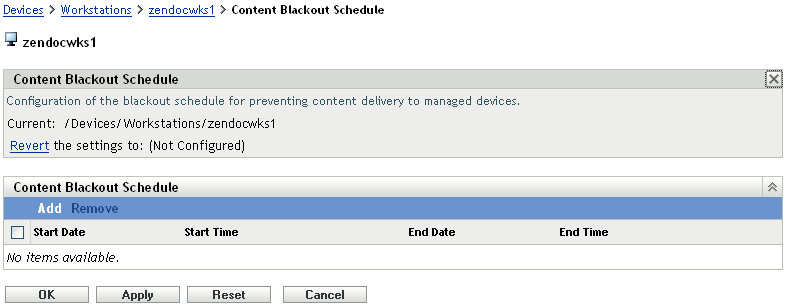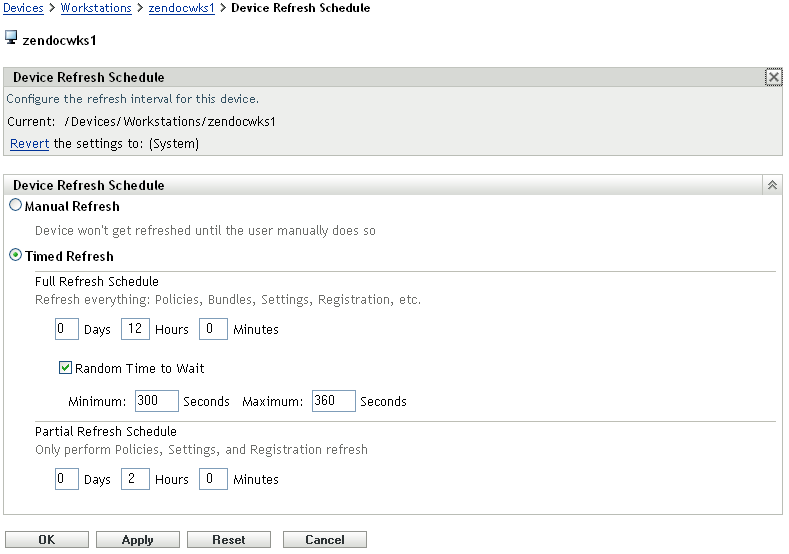13.3 Content Delivery
Content delivery, or distribution, refers to the process of transferring bundle and policy content from a content server (ZENworks Primary Server or Satellite with the Content role) to a managed device.
There are a variety of settings you can use to determine how content is delivered to managed devices, such as setting up Closest Server rules, setting delivery blackout dates for when content can’t be downloaded, and setting how often you want managed devices to look for new content to download.
For information about performing these tasks, see the following sections:
13.3.1 Setting Up Location Closest Server Rules
When you have multiple content servers, you can use the Closest Server rules to determine which content server a managed device uses to download content. The Location Closest Server rules let you map devices to content servers based on many network parameters (DNS names, IP addresses, Gateways etc).
For more information, see Section 12.5, Adding Closest Servers to Locations.
13.3.2 Scheduling Delivery Blackout Dates
If there are times when you don’t want managed devices to download content, you can create a content blackout schedule. Schedules can be defined at the following levels:
-
Management Zone: The schedule is inherited by all devices.
-
Device Folder: The schedule is inherited by all devices within the folder and its subfolders. It overrides the Management Zone blackout schedule.
-
Device: The schedule applies only to the device for which it is defined. It overrides any schedules set at the Management Zone and folder levels.
A blackout schedule can include one or more time periods.
NOTE:The Content Blackout Schedule setting lets you prevent managed devices from downloading content from a content source during the blackout period. This setting, however, does not affect content replication. For this reason, a Satellite device with the Content role can still replicate content from its parent primary server during the blackout period.
To create a content blackout schedule:
-
Launch ZENworks Control Center.
-
Do one of the following:
-
To create a content blackout schedule for your Management Zone, click the Configuration tab, then click Content (in the Management Zone Settings panel) > Content Blackout Schedule.
-
To create a content blackout schedule for a device folder, open the folder’s details page, then click Settings > Content (in the Settings panel) > Content Blackout Schedule.
-
To create a content blackout schedule for a device, open the device’s details page, click Settings > Content (in the Settings panel) > Content Blackout Schedule.

-
-
If you are creating content blackout schedules for a device or device folder, click Override settings to activate the Content Blackout Schedule panel.
-
Click Add to display the Specify Blackout Time Period dialog box, then fill in the following fields:
Start Date: Select the first date you want to include in the schedule.
End Date: Select the last date you want to include in the schedule. The blackout time period (specified by the start and end times) occurs on each day from the start date to the end date.
Start Time: Select the hour you want the blackout time period to start each day.
End Time: Select the hour you want the blackout time period to end each day. If you want the blackout time period to extend for 24 hours, select the same time as the start time.
-
Click OK to save the blackout period.
-
Repeat Step 4 to create additional blackout periods.
-
When you are finished, click OK or Apply to save the schedule.
13.3.3 Setting the Device Refresh Schedule
At device startup, the ZENworks Adaptive Agent on a device contacts a ZENworks Server to refresh its information. If information changes after startup, the Adaptive Agent must refresh its information again before the changes can show up on the device.
If the refreshed information indicates that there is new content to be downloaded, the Adaptive Agent contacts its content server and begins the download process.
You can use the device refresh schedule to determine how often a device contacts a ZENworks Server to update bundle, policy, configuration, and registration information. Schedules can be defined at the following levels:
-
Management Zone: The schedule is inherited by all devices.
-
Device Folder: The schedule is inherited by all devices within the folder and its subfolders. It overrides the Management Zone schedule.
-
Device: The schedule applies only to the device for which it is defined. It overrides any schedules set at the Management Zone and folder levels.
To create a device refresh schedule:
-
Launch ZENworks Control Center.
-
Do one of the following:
-
To create a device refresh schedule for your Management Zone, click the Configuration tab, then click Device Management (in the Management Zone Settings panel) > Device Refresh Schedule.
-
To create a device refresh schedule for a device folder, open the folder’s details page, then click Settings > Device Management (in the Settings panel) > Device Refresh Schedule.
-
To create a device refresh schedule for a device, open the device’s details page, then click Settings > Content (in the Settings panel) > Device Refresh Schedule.

-
-
If you are creating a device refresh schedule for a device or device folder, click Override settings to activate the Device Refresh Schedule panel, then choose from the following schedules:
Manual Refresh: If you want a device refreshed only when its user manually initiates the refresh, select Manual Refresh, then click Apply. Users can initiate a refresh by clicking the ZENworks icon located in the desktop’s notification area (system tray).
Timed Refresh: Select Timed Refresh if you want to establish a refresh schedule. You can use a Full Refresh Schedule or a Partial Refresh Schedule:
-
Full Refresh Schedule: Defines how often you want a device to update all of its information from the ZENworks Server, including bundle, policy, setting, and registration information. Use the following fields to create the full refresh schedule:
-
Days, Hours, Minutes: Specifies the amount of time between refreshes. For example, to set a refresh interval of 8.5 hours, you would specify 0 Days, 8 Hours, 30 Minutes. The default is 12 hours.
-
Random Time to Wait: Select this option to ensure that multiple devices with the same refresh schedule do not all initiate their refresh at the same time. For example, if you have 1000 devices with the same refresh schedule, you might overburden your ZENworks Server. By selecting this option, the device waits a randomly generated amount of time before initiating its refresh. Use the Minimum and Maximum fields to specify the range (in seconds) for the randomly generated time.
-
-
Partial Refresh Schedule: Defines how often you want a device to update its policy, configuration setting, and registration information from the ZENworks Server. Bundle information is not updated.
In the Days, Hours, and Minutes fields, specify the amount of time between refreshes. For example, to set a refresh interval of 3 hours, you would specify 0 Days, 3 Hours, 0 Minutes. The default is 2 hours.
The Timed Refresh setting is applicable to both the full and partial refreshes.
The refresh interval is not reset until the device refresh is complete. For example, assume you set a refresh interval of 8 hours. The device’s first refresh occurs at 6:00 p.m. and takes 13 seconds to complete. The second refresh occurs at 2:00:13 a.m. (8 hours after the refresh was completed at 6:00:13). If the second refresh takes 15 seconds to complete, the third refresh occurs at 10:00:28 a.m.
-
-
When you are finished, click OK or Apply to save the schedule.